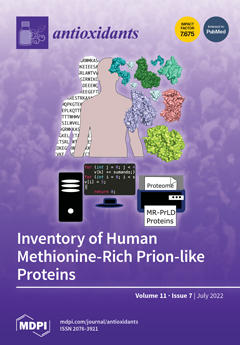Rett syndrome (RTT) is a severe neurodevelopmental disorder that typically arises from spontaneous germline mutations in the X-chromosomal methyl-CpG binding protein 2 (
MECP2) gene. For the first 6–18 months of life, the development of the mostly female patients appears normal. Subsequently,
[...] Read more.
Rett syndrome (RTT) is a severe neurodevelopmental disorder that typically arises from spontaneous germline mutations in the X-chromosomal methyl-CpG binding protein 2 (
MECP2) gene. For the first 6–18 months of life, the development of the mostly female patients appears normal. Subsequently, cognitive impairment, motor disturbances, hand stereotypies, epilepsy, and irregular breathing manifest, with previously learned skills being lost. Early mitochondrial impairment and a systemic oxidative burden are part of the complex pathogenesis, and contribute to disease progression. Accordingly, partial therapeutic merits of redox-stabilizing and antioxidant (AO) treatments were reported in RTT patients and
Mecp2-mutant mice. Pursuing these findings, we conducted a full preclinical trial on male and female mice to define the therapeutic value of an orally administered AO cocktail composed of vitamin E, N-acetylcysteine, and α-lipoic acid. AO treatment ameliorated some of the microcephaly-related aspects. Moreover, the reduced growth, lowered blood glucose levels, and the hippocampal synaptic plasticity of
Mecp2−/y mice improved. However, the first-time detected intensified oxidative DNA damage in
Mecp2-mutant cortex persisted. The behavioral performance, breathing regularity, and life expectancy of
Mecp2-mutant mice did not improve upon AO treatment. Long-term-treated
Mecp2+/− mice eventually became obese. In conclusion, the AO cocktail ameliorated a subset of symptoms of the complex RTT-related phenotype, thereby further confirming the potential merits of AO-based pharmacotherapies. Yet, it also became evident that long-term AO treatment may lose efficacy and even aggravate the metabolic disturbances in RTT. This emphasizes the importance of a constantly well-balanced redox balance for systemic well-being.
Full article






